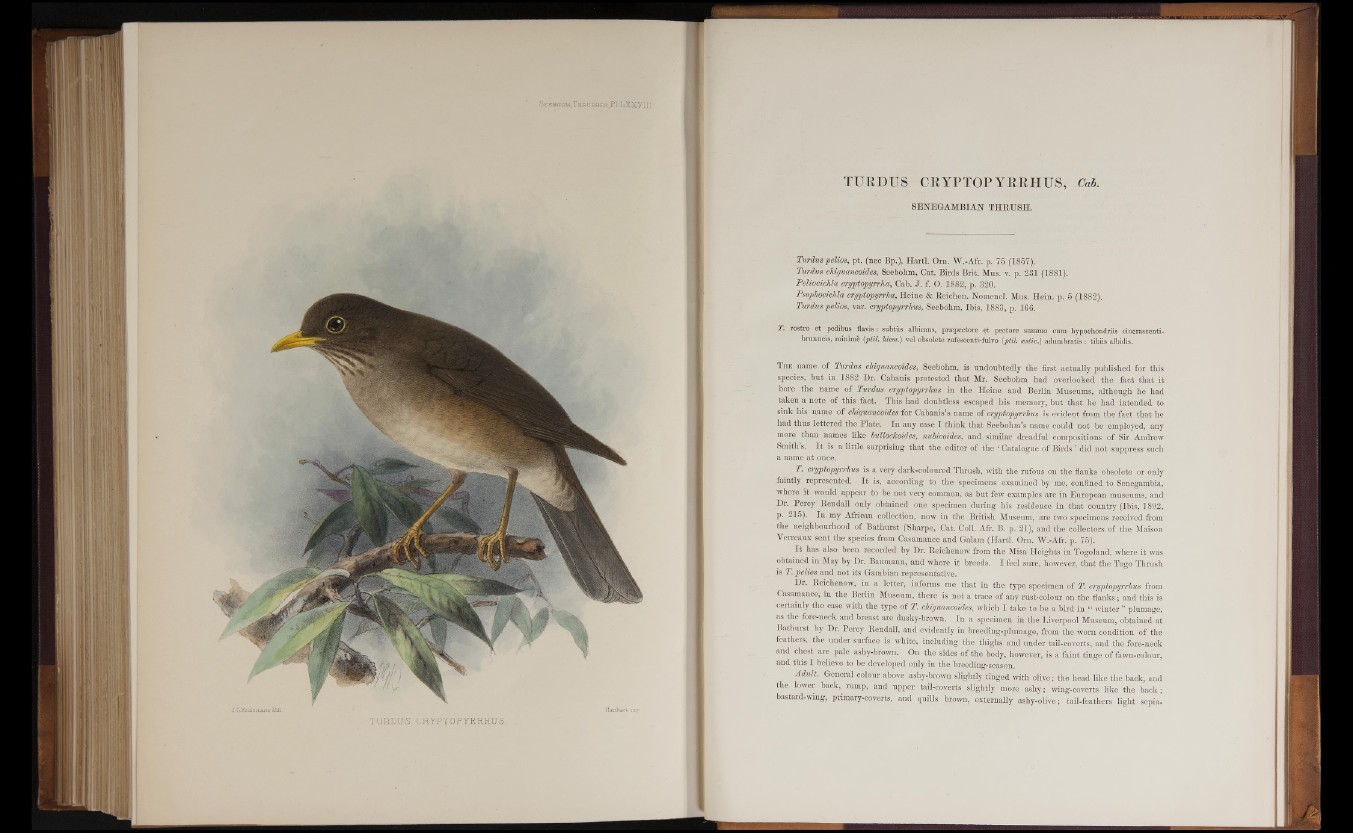
TURD O S CRYPT OP TRRH'CJ S
Hanha rt imp
TURDUS CRYPTOPYRRHUS, Cab.
SENEGAMBIAN THRESH.
Turdus pelios, pt. (nee Bp.), Hartl. Om. W.-Afr. p. 75 (1857).
Turdus chiguancoides, Seebohm, Cat. Birds Brit. Mus. v. p. 281 (1881).
Peliociclila cryptopyrrha, Cab. J. f. O. 1882, p. 320.
Psophocichla cryptopyrrha, Heine & Reichen. Nomencl. Mns. Hein. p. 5 (1882).
Turdus pelios, var. cryptopyrrhus, Seebohm, Ibis, 1883, p. 166.
T. rostro et pedibus flavis: suibtiis albicans, praepectore et pectore summo cum hypochondriis cinerascenti-
brunneis, minime (ptil. Hem.) vel obsolete rufescenti-fulvo (jptil. eestiv.) adumbratis : tibiis albidis.
T he name of Turdus chiguancoides, Seebohm, is undoubtedly the first actually published for this
species, but in 1882 Dr. Cabanis protested that Mr. Seebohm had overlooked the fact that it
bore the name of Turdus cryptopyrrhus in the Heine and Berlin Museums, although he had
taken a note of this fact. This had doubtless escaped his memory, but that he had intended to
sink his name of chiguancoides for Cabanis’s name of cryptopyrrhus is evident from the fact that he
had thus lettered the Plate. In any case I think that Seebohm’s name could not be employed, any
more than names like bullocJcoides, nubicoides, and similar dreadful compositions of Sir Andrew
Smith s. It is a little surprising that the editor of the * Catalogue of Birds ’ did not suppress such
a name at once.
T. cryptopyrrhus is a very dark-coloured Thrush, with the rufous on the flanks obsolete or only
faintly represented. It is, according to the specimens examined by me, confined to Senegambia,
where it would appear to be not very common, as but few examples are in European museums, and
Dr. Percy Rendall only obtained one specimen during his residence in that country (Ibis, 3 892,
p. 215). In my African collection, now in the British Museum, are two specimens received from
the neighbourhood of Bathurst (Sharpe, Cat. Coll. Afr. B. p. 21)', and the collectors of the Maison
Verreaux sent the species from Casamance and Galam (Hartl. Orn. W.-Afr. p. 75).
It has also been recorded by Dr. Reichenow from the Misa Heights in Togoland, where it was
obtained in May by Dr. Baumann, and where it breeds. I feel sure, however, that the Togo Thrush
is T. pelios and not its Gambian representative.
Dr. Reichenow, in a letter, informs me that in the type specimen of T. cryptopyrrhus from
Casamance, in the Berlin Museum, there is not a trace of any rust-colour on the flanks; and this is
certainly the case with the type of T. chiguancoides, which I take to be a bird in “ winter ” plumage,
as the fore-neck and breast are dusky-brown. In a specimen in the Liverpool Museum, obtained at
Bathurst by Dr. Percy Rendall, and evidently in breeding-plumage, from the worn condition of the
feathers, the under surface is white, including the thighs and under tail-coverts, and the fore-neck
and chest are pale ashy-brown. On the sides of the body, however, is a faint tinge of fawn-colour,
and this I believe to be developed only in the breeding-season.
Adult. General colour above ashy-brown slightly tinged with olive; the head like the back, and
the lower back, rump, and upper tail-coveits. slightly more ashy; wing-coverts like the back;
bastard-wing, primary-coverts, and quills brown, externally ashy-olive; tail-feathers light sepia